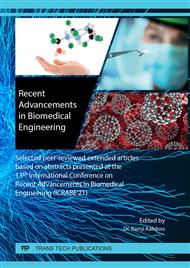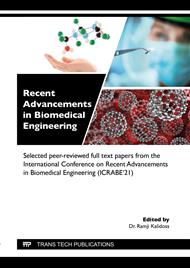p.59
p.67
p.73
p.79
p.85
p.91
p.97
p.105
p.111
Smart Mesoporous Silica Nanocomposite for Triggered and Targeted Ibuprofen Drug Delivery
Abstract:
Mesoporous silica nanocomposite (MSNC) with a wall thick of around 10 nm were created using Fe3O4 nanoparticles as the inorganic template. In accordance with the results of SEM and BET analysis, MSNC were homogenous spherical particles with good dispersion, and their specific surface area it possible that Ibuprofen will become stuck within the MSNC carrier. Loading of drug shows a decline in a surface area from 225.08 to 69.25 m2 g-1, pore volume from 0.56 to 0.13cm g-1 and the pore diameter from 7.96 to 6.74 nm correspondingly. The amount of Ibuprofen entrapped in the carrier was measured by UV spectroscopy and total glycerol (TG) measurement, respectively. It was determined pore size distribution of MSNC changed before and after Ibuprofen entrapment. The release profile of Ibuprofen from MSNC was characterised by a three-stage pattern with an influence on the time between each stage.
Info:
Periodical:
Pages:
111-115
Citation:
Online since:
August 2022
Keywords:
Price:
Сopyright:
© 2022 Trans Tech Publications Ltd. All Rights Reserved
Share:
Citation:



